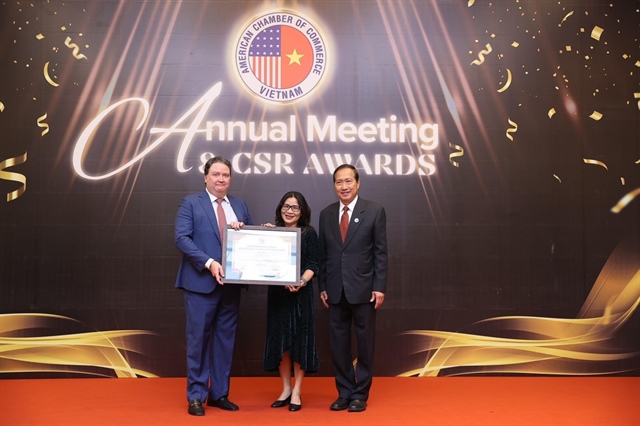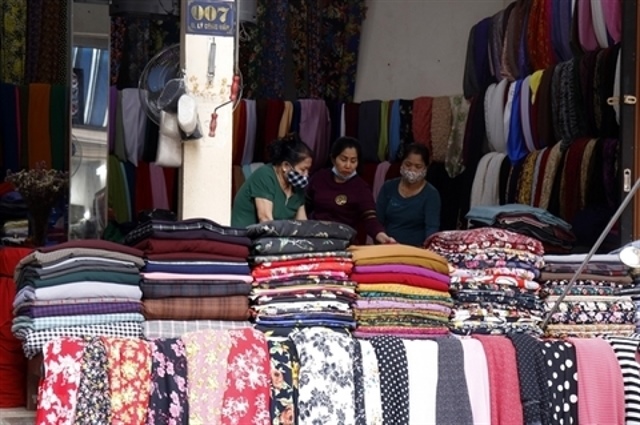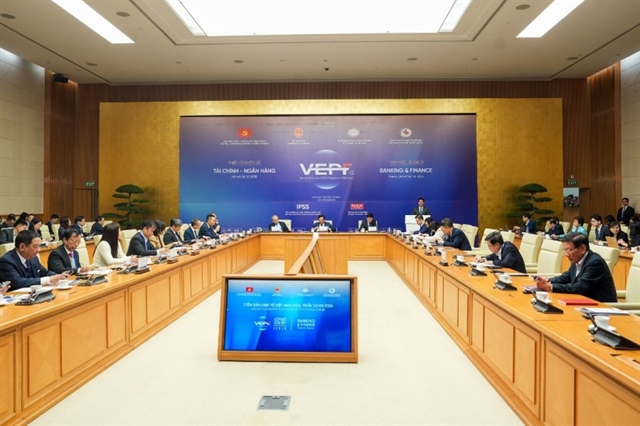Bank credit growth slow despite rate cut
Bank credit growth slow despite rate cut
In the first quarter of the year, the State Bank of Viet Nam reported that the sector's volume of credit shrank by 1.96 per cent compared with the figure recorded at the end of last year.
Meanwhile, the National Financial Supervisory Committee predicted that by mid-April, credit grew by only 0.25 per cent, much lower than the expected figure of 1.5 per cent per month.
Despite the central bank's efforts to cut interest rates to increase lending, banks continued to have negative credit growth and still recorded minus1.71 per cent growth by mid April.
The banking sector has set a yearly target of achieving credit growth of 15-17 per cent in hopes of making a contribution to raising the country's Gross Domestic Product (GDP) growth rate to between 6 per cent and 6.6 per cent this year.
However, many independent experts said that even if banks achieved average credit growth rate of 2 per cent per month for the rest of the year, the entire banking sector's credit growth would reach maximum 14 per cent.
So the projected monthly credit growth rate of 2 per cent seemed to be unrealistic.
Many banks that were given a credit-growth quota of 17 per cent per year are unsure about what they need to do.
The Export-Import Joint Stock Commercial Bank (Eximbank), for example, always had to curb credit growth but now has a minus 5 per cent growth rate.
In addition, the Asia Commercial Joint Stock Bank's capital disbursement is quite slow, even though the bank's interest rates of loans given to good customers are only 15 or 16 per cent per annum.
Banking sector insiders also said that in an attempt to increase credit growth, many banks had tried to lower their lending interest rate to 15 per cent or even 14 per cent per year so that enterprises could access them.
However, banks still could not find qualified customers to lend.
Nguyen Huu Dang, general director of the HCM City Development Joint Stock Commercial Bank (HDBank), also said the bank's credit growth in the first quarter of the year shrank by 5 per cent.
The capital demand of enterprises, particularly those with feasible projects, has fallen significantly, and banks are reluctant to lend because of fear of bad debts, according to Dang.
Many enterprises do not want to borrow capital because they cannot cope with rising inventories. And others have had to cut their product prices and suffer losses. Even so, sales remain low.
The director of a plastics company in HCM City, who declined to be named, said that, even when the interest rate of bank loans was cut to 10 per cent per year, the company did want to borrow because it feared that it couldn't pay back its debt.
Market analysts said the major problem was not interest rates but consumption. Because of low sales, companies were delaying any plans for investment, production or trading.
To utilise their available capital and generate profit, many banks have recently bought treasury bills which have a modest interest rate but are safe.
But that may only be a short-term solution because the central bank has just decided to reduce the number of treasury bill transactions from one a day to one a week.
Stockpiles on the up
Many kinds of commodities, from expensive to cheap products, from food to household appliances, are piling up in warehouses because of slow consumption rates.
At the same time, enterprises cannot recover capital to continue their production and reinvestment activities.
According to sector insiders, the market's textile and garment purchasing power has fallen by 50 per cent, compared with the same period last year.
Dang Quynh Trang, general director of the Viet Thy Fashion Company, said her company had to cut the price of several kinds of products by 50 – 70 per cent to settle the growing unsold inventory.
Many other apparel companies, which have enough stock on hand for the rest of the year, are holding big sale promotions such as "buy one, get one" to increase sales.
Do Long, general director of the Binh Tan Consumer Goods Manufacturing Company, said the volume of the company's footwear that had been sold in the first quarter of the year dropped by 25 per cent.
Enterprises' inventories are usually maintained at under 20 per cent, but Bita's products in stock increased 35 per cent by April, according to Long.
In the last four months, Ha Tien Cement Company No1 sold only 1.2 million tonnes of cement, a year-on-year decrease of 12 per cent.
Many electronics trade centres in HCM City also revealed that their turnover in the first four months dropped by 15-20 per cent.
Inventories of soft drinks, processed food and cosmetics at Citimart and Maximark supermarkets have climbed as well. They are valued at tens of billions of dong.
In addition to consumer goods, other essential commodities such as fertiliser, cement and plant-protection products also have inventories that have increased 39-63 per cent.
According to the General Statistics Department, the country's unsold inventory index by April had increased by 32 per cent compared with the same period last year.
Industries that have the largest inventory volumes include casting, fruit and vegetable processing, fertiliser, cement, auto and motorbike, fisheries, and garments and textiles.
To cope with the rising inventory and have cash to maintain operations, several enterprise are using their products instead of cash to pay debts, although they have had to suffer certain losses. Some have had to barter away their products at much low prices.
Le Thi Thuy, director of the MM Event and Telecommunications Company in District 2, said her company had just received three trucks of confectioneries and snacks worth VND120 million (US$5,710) from a big enterprise which would have normally paid their bill of VND100 million ($4,760) in cash.
"Because the enterprise could not sell their products, they had no money to pay us and had to use the products instead," Thuy explained.
To get capital to pay salaries, she said her company had to ask staff to take part in selling the confectioneries and snacks. They collected only VND65 million ($3,100).
Both companies knew that they would suffer losses, but they had no other choice.
Foreigners return to real estate
While domestic investors are seeking ways to flee from real estate projects, a prime cause of bad debts at banks, many foreign enterprises have begun new high-value investment activities.
Several sources also forecast that foreign direct investment pumped into the real estate sector would see positive changes this year.
For the first four months of the year, foreign investors injected $1.57 billion into real estate projects in Viet Nam.
One of them was the Binh Duong Garden City joint-venture, with investment capital of $1.2 billion.
The project, whose construction work began in March, covers an area of 71 ha of prime land in the centre of Binh Duong New City project. It was developed under an alliance between Viet Nam's Becamex IDC and Japan Tokyu Corporation.
A report from Dau Tu newspaper also says that Korea Development Bank (KDB) has decided to pump $200 million into the first phase of construction of the centre of the Tay Ho Tay urban area in Ha Noi, with Daewoo E&C being the project owner.
The capital mobilised from the KDB would enable Daewoon E&C to begin the project by the end of this year.
The first phase of the Ho Tram Strip Project in Ba Ria-Vung Tau Province will be put into operation in February 2013.
The project, funded by Canada's Asian Coast Development Limited Company, has total investment capital of $4.23 billion and covers 164 ha with five-star standard facilities.
In addition to directly investing in real estate projects in Viet Nam, some foreign enterprises are seeking ways to penetrate the domestic real estate market under the mergers and acquisitions (M&A) form.
According to some foreign investors, real estate prices in the Vietnamese market are at a low level, thus creating opportunities for those who want to buy unfinished property projects whose owners have met financial difficulties.
Malaysia's leading property developer, S P Setia Berhad, who owns Ecolakes My Phuoc and Eco Xuan in Binh Duong Province, for instance, has plans to extend investments into real estate projects under the M&A form in Ha Noi and HCM City
vietnamnews




















